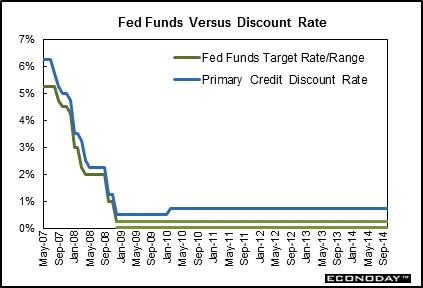
|
Summary of Latest FOMC Decision The FOMC statement at the end of the October 28-29, 2014 FOMC meeting, left policy rates unchanged but the Fed announced an end to quantitative easing—the bond purchase programs. But reinvestment of existing assets continues.
Guidance on future policy rate increases continues to be based on economic conditions, specifically reflecting the unemployment rate and inflation expectations—plus other information on the economy in general. Policy rates are to remain low for "some time."
Long Term Perspective The Fed's primary policy tool is setting the fed funds target rate. Fed funds are loans that banks make to each other on the open market. These short-term loans are to help banks that are short on reserves to meet reserve requirements. The Fed directly controls the fed funds rate by how much money the Fed injects or withdraws from the financial system.
Over the current decade, the Fed has adjusted the fed funds target rate to address, recession, inflation, and other economic issues. The Fed cut the fed funds target rate from January 3, 2001 through November 6, 2002 in response to a recession, fears of deflation, and weak economic growth after the end of the 2001 recession. The Fed began a tightening cycle on June 30, 2004 which ended with a seventeenth consecutive increase on June 29, 2006. The tightening was intended to preclude unacceptably high inflation. The Fed began an easing cycle on August 17, 2007 when the Fed cut its discount rate by 50 basis points and then in the following months began multiple cuts in both the fed funds rate and discount rate. These cuts were intended to preclude recession and to help stabilize financial markets after the break out of the sub-prime crisis in mid-2007. Now, the Fed is keeping rates low to help strengthen the sluggish recovery.
A lesser known policy tool is the Fed's discount rate. This is the rate the Fed charges banks for borrowing reserves from the Fed's discount window at regional Federal Reserve Banks. In January 2003, the Fed instituted a primary credit and secondary credit discount rate. Traditionally, the primary credit discount rate is set at 100 basis points over the federal funds target rate, while the secondary credit rate is set at 150 basis points over the fed funds target rate. But over the current easing cycle, the Fed has reduced this gap down to 25 basis points for the primary credit discount rate (above the top of the range for the fed funds target). With the February 19, 2010 increase in the discount rate, the Fed started the process of returning to a normal spread but has made no further hikes in the discount rate (through the October 28-29, 2014 FOMC meeting) since this move.
Short Term Perspective At its October 28-29 policy meeting, the Fed as expected left policy rates unchanged and ended quantitative easing. The fed funds target rate remains at a range of zero to 0.25 percent. As expected, the Fed announced that its bond purchases programs ended in October. There was one dissent from Minneapolis Fed president Kocherlakota who preferred to keep the current level of quantitative easing.
The FOMC characterized the economy as "expanding at a moderate pace" and with labor market conditions improved somewhat further, with solid job gains and a lower unemployment rate. The Fed is seeing the labor market as gradually improving.
The Fed is looking beyond recently weak inflation numbers from lower energy costs and sees inflation edging up.
"Although inflation in the near term will likely be held down by lower energy prices and other factors, the Committee judges that the likelihood of inflation running persistently below 2 percent has diminished somewhat since early this year."
Regarding quantitative easing, the Fed as expected ends bond purchases this month but continues to maintain asset levels.
"Accordingly, the Committee decided to conclude its asset purchase program this month. The Committee is maintaining its existing policy of reinvesting principal payments from its holdings of agency debt and agency mortgage-backed securities in agency mortgage-backed securities and of rolling over maturing Treasury securities at auction. This policy, by keeping the Committee's holdings of longer-term securities at sizable levels, should help maintain accommodative financial conditions."
Guidance on future increases in policy rate increases was vague and indicated continued data dependency.
The one dissenting vote was for keeping quantitative easing at a modest pace with low inflation a key concern.
"Voting against the action was Narayana Kocherlakota, who believed that, in light of continued sluggishness in the inflation outlook and the recent slide in market-based measures of longer-term inflation expectations, the Committee should commit to keeping the current target range for the federal funds rate at least until the one-to-two-year ahead inflation outlook has returned to 2 percent and should continue the asset purchase program at its current level."
There were no surprises in the October FOMC decision other than who dissented. The Fed remains dovish with inflation remaining below the Fed's 2 percent target at 1.7 percent. Policy rates are likely to remain low for quite some time. New information on Fed views on policy rate changes will come with quarterly Fed forecasts out with the December statement.
|
||||||||||
| Legal Notices | ©Copyright 1998-2025 Econoday, Inc. |
powered by
![[Econoday]](images/logo.gif)
![[Apple App Store]](/images/AppleAppStore.png) ![[Econoday on Kindle]](/images/kindle.jpg) 
|
|||||||||

